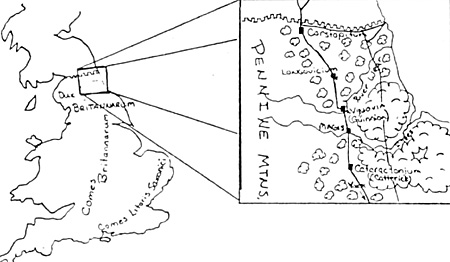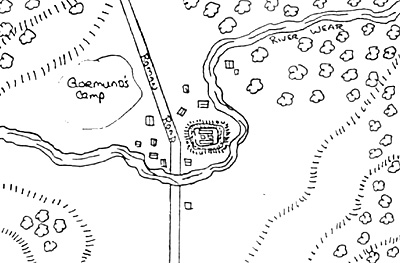 So far I have covered Arthur's battles at Glein, Dubglass, Bas and the Caledonian Wood.
Next on Nennius' list is the Battle at For Guinnion. "The eigth battle was in the fort Guinnion in
which Arthur carried the image of St. Mary, ever virgin, on his shoulders and the Pagans were
turned to flight on that day and a great slaughter was upon them through the virtue of our Lord
Jesus Christ and through t virtue of St. Mary the Virgin, his mother."
So far I have covered Arthur's battles at Glein, Dubglass, Bas and the Caledonian Wood.
Next on Nennius' list is the Battle at For Guinnion. "The eigth battle was in the fort Guinnion in
which Arthur carried the image of St. Mary, ever virgin, on his shoulders and the Pagans were
turned to flight on that day and a great slaughter was upon them through the virtue of our Lord
Jesus Christ and through t virtue of St. Mary the Virgin, his mother."
Until recently the battle at Guinnion was thought of as either mythical or in an area conquered by the Saxons in East Britain. In either case its location would be lost to us, but as luck would have it, there is a third alternative.
Norma Goodrich in her book *King Arthur" has Suggested that Guinnion might possibly be the old Roman fort Vinovia. Later known Binchester, Vinovia is between 20 and 30 miles to the south Of Hadrian's Wall and 20 miles north of Catterick from the poem Y GODODDIN. It is in the region the Briton's called Brynaich which later became Bernicia. The Romans built it as an auxiliary fort where cavalry was based. In the late Empire an officer known as a Beneticiarii Consularis was stationed there and in 367 a new private bath was added. But the Roman army was in decline in Britain and in the 43 years between the construction of the bath and the end of Roman occupation in the north (410 AD), the Private bath was converted to communal bath and later to a slaughter house. It was abandoned when the Romans pulled out of Britain. I have not been able to find any diagrams of what Vinovia looked like, but it is reasonable to assume that it was similar to other auxiliary forts in Britain.
By the second half of the fifth century it was probably in state of disrepair, as were most Roman buildings. Since there was a high ranking Roman officer there in the past, the tradition may have carried over and it may have been used as a local warlord's 'stronghold' or a place of refuge for the nearby village., The "Pagans" in Arthur's time may have been raiding Saxons, Picts, or a rebellious British faction. Picts or Saxons would have come from the sea.
Saxon Background
 Gormund looked at the faces around the fire. Brecca's toothless
and scared face showed his years of raiding...and his lust for blood
and riches. Aelfric was Up and pacing around the the group of men.
Gormund knew he was anxious about the 'demon horses'. The wound he
got at Bassag was deep indeed. They had taken much booty today, the
Briton lord cowering behind his walls afraid. The whole region was
their's for the picking. Just another day or two and all of the
raiding Parties would return. Then they would be on their way home.
Gormund looked at the faces around the fire. Brecca's toothless
and scared face showed his years of raiding...and his lust for blood
and riches. Aelfric was Up and pacing around the the group of men.
Gormund knew he was anxious about the 'demon horses'. The wound he
got at Bassag was deep indeed. They had taken much booty today, the
Briton lord cowering behind his walls afraid. The whole region was
their's for the picking. Just another day or two and all of the
raiding Parties would return. Then they would be on their way home.
Saxon Forces:
C in C (Gormund)w/3 HI, Irr'B',JLS,Sh and P Standard 132
Subgeneral (Aelfric) w/3 Irr'B' HI, JLS Sh 68
Allied General (Brecca) w/ 3 Irr'B',Hl, JLS, Sh. 93
1 x 20 Gormund's warband Irr'B' HI, JLS, Sh 145
2 x 24 Gormund's warriors Irr'C', MI, JLS, Sh 194
1 x 20 Brecca's warb an d Irr 'B' HI, JLS, Sh 145
2 x 24 Brecca's warriors Irr 'C' MI, JLS, Sh 194
1 x 20 Aelfric's warband Irr 'B', HI, JLS, Sh 145
3 x 16 Raiding Parties Irr 'C' MI, JLS, Sh 219
1 x 10 Saxon Archers Irr'C' LI, B 45
total 1380
British Background:
Arthur was on the road north again! There had not been any trouble from the Saxons for nearly two years now. A saxon host was raiding Brynaich. The local lord Cummanius went to meet them but was defeated. Now he was holding up in an old Roman fort. Messengers were out to all the kings in the area, but he didn't know how many would respond.
Ambrosius had taken an army to Armorica. The colonies down there were Pleading for help. The Saxons were settling along the Loire River, encroaching on British territory. He had made an alliance with Syagrius, self-styled *King of the Romans'. They would start at opposite ends of the Loire and drive saxons before them.
Arthur was left behind as COMES BRITAINORUM. Ambrosius even arranged a marriage for him with the King of Durrinonia's daughter Gwenyfar. He carried the shield she had given him. It had a picture of St. Mary on it. He had never given much thought to religon personally, but the image of a champion of Christianity wouldn't hurt when it came time to draw annona, or the provisions tax, from the church. Gwenyfar had several good ideas he would have to use.
British Forces:
1 CinC (Arthur) w/ 5 HC, Reg A, JLS, Sh + PA Standard 190
1 Subgeneral (Commanius) w/ 2 LMI Irr 'C' JLS, Sh 56
1 Allied General (Marchlew) wl 5 HCqIrr'B' JLS, Sh 108
3 Y 9 Briton Cavalry Irr.'B' HC, JLS, Sh 318
1 x 21 Brynaich levy Irr.'C', LMI, JLS, Sh 88
2 x 10 Brynaich Archers Irr.'C', LI, B 90
1 x 24 Marchlew's Eboricum cohort Reg.'D' LMI, JLS Sh 82
2 x 30 Marchlew's Eboricum Levy Irr'C' LMI JLS Sh 230
1 x 10 Marchlew's Eboricum archers Irr'C', LI, B 45
240p x 120p dry stone fortifications with gate 140
240P x 120P dry ditch 30
total 1377
In this scenario, Gormund, Brecca, and Aelfric and their hosts start out in Gormund's camp. The Saxon archers can be Placed anywhere. The Saxon raiding parties must dice separately for entry as per WRG flank marches. Comyranius and the Brynaich forces are inside the fort. Marchlew's army will dice for arrival and enter an the south side of the table. Arthur and his knights dice for arrival also, they can enter on the east, south, or west sides of the table. Any force entering the table before turn 3 or after turn 5 rolls 1D6 for that forces fatigue points gained forced-marching to the battle site.
Back to Saga # v2n2 Table of Contents
Back to Saga List of Issues
Back to MagWeb Magazine List
© Copyright 1987 by Terry Gore
This article appears in MagWeb.com (Magazine Web) on the Internet World Wide Web. Other articles from military history and related magazines are available at http://www.magweb.com